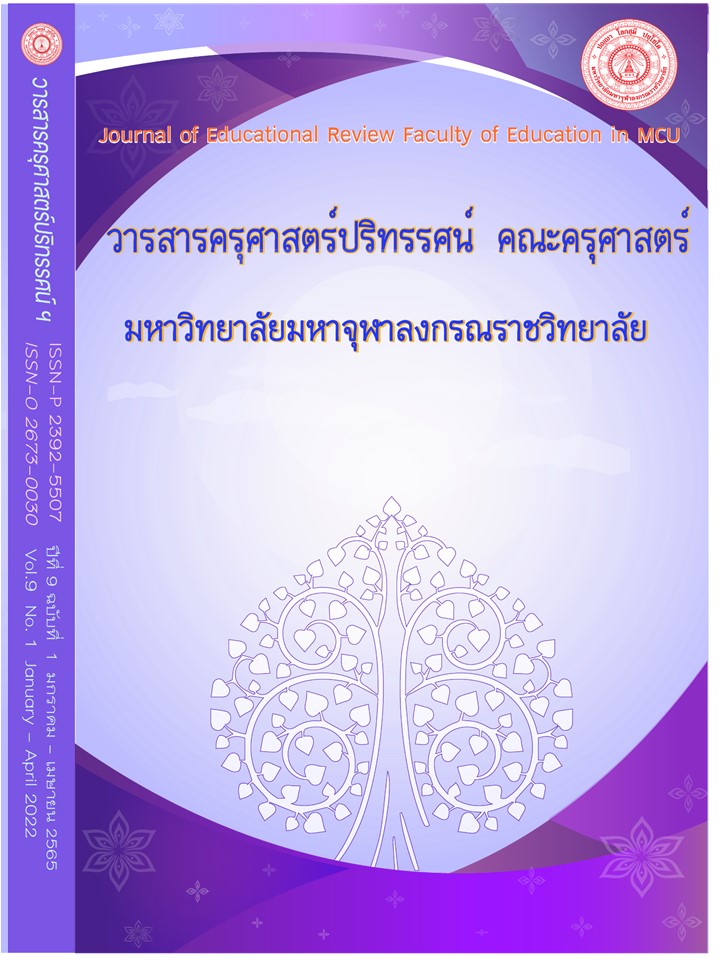TPACK FOR SCIENCE LEARNING : TPACK FOR BIOLOGY LEARNING
Main Article Content
Abstract
This research article is the integration among Content knowledge, Pedagogy knowledge and Technology knowledge as a tool to promote learners' learning process and to develop the teaching process of teachers keeping up with the world. The purposes of the research were to develop and evaluate TPACK storage learning guidelines in biology for lower secondary level. Research methods were to define the concept of biology and develop TPACK learning guidelines, then create teaching scenarios. The experts considered the exactness and appropriateness of TPACK learning guideline developed. The samples of this research consisted of university science teachers, biology experts from The Institute for the Promotion of Teaching Science and Technology, and educational supervisors. The research tool was questionnaire about teaching scenario of biology assessment. Data was analyzed by descriptive statistics and content analysis. The research findings are as follows: 1) There are four main concepts in biology for lower secondary level; plant life, human life, ecosystem and diversity. Main concepts can be divided into 11 sub concepts. Each of sub concept has 4 learning guidelines. A total of TPACK learning guidelines is 44 learning guidelines 2) Most experts considered that TPACK learning guidelines are diversified, attractive attention for the learners. Technologies and knowledges chosen are clear and appropriate at high and the most high levels. TPACK learning guidelines are able to promote and enhance the learning efficiency.
Article Details

This work is licensed under a Creative Commons Attribution-NonCommercial-NoDerivatives 4.0 International License.
ทัศนะและความคิดเห็นที่ปรากฏในบทความในวารสารฉบับนี้ถือเป็นความรับผิดชอบของผู้เขียนบทความนั้นเพียงผู้เดียว และไม่ถือเป็นทัศนะและความรับผิดชอบของกองบรรณาธิการ
กองบรรณาธิการขอสงวนสิทธิ์ในการคัดเลือกบทความลงตีพิมพ์และจะแจ้งให้เจ้าของบทความทราบหลังจากผู้ประเมินบทความตรวจอ่านบทความแล้ว
ต้นฉบับที่ได้รับการตีพิมพ์ในวารสารครุศาสตร์ปริทรรศน์ คณะครุศาสตร์ มหาวิทยาลัยมหาจุฬาลงกรณราชวิทยาลัย ถือเป็นกรรมสิทธิ์ของคณะครุศาสตร์ มหาวิทยาลัยมหาจุฬาลงกรณราชวิทยาลัย ห้ามนำข้อความทั้งหมดหรือบางส่วนไปพิมพ์ซ้ำ เว้นเสียแต่ว่าจะได้รับอนุญาตจากมหาวิทยาลัยฯ เป็นลายลักษณ์อักษร
References
กระทรวงศึกษาธิการ. (2551). แนวทางการจัดกิจกรรมการเรียนรู้ตามหลักสูตรการศึกษาขั้นพื้นฐานพุทธศักราช 2551. กรุงเทพมหานคร: โรงพิมพ์คุรุสภาลาดพร้าว.
กองนโยบายและแผนสำนักงานคณะกรรมการการศึกษาเอกชน. (2549). เอกสารชุดแนวทางพัฒนาและรับรองคุณภาพการศึกษาเอกชน เล่มที่ 1 ฉบับผู้แทน สช. กรุงเทพมหานคร: โรงพิมพ์การศาสนา.
จันทวรรณ ปิยะวัฒน์. (2555). การวิจัยเชิงสำรวจอุปสรรคที่มีผลต่อความตั้งใจในการแลกเปลี่ยนเรียนรู้ทางออนไลน์ของผู้ใช้งานในชุมชนออนไลน์. วารสารวิทยาการจัดการ. 30 (1). 91.
ชัยณรงค์ แก้วสุก. (2550). ผลของการเรียนการสอนชีววิทยา โดยใช้รูปแบบ ED3U ร่วมกับคอมพิวเตอร์สถานการณ์จำลองที่มีต่อทักษะกระบวนการทางวิทยาศาสตร์ และความคงทนในการเรียนรู้ของนักเรียนมัธยมศึกษาตอนปลาย. วิทยานิพนธ์ครุศาสตรมหาบัณฑิต. จุฬาลงกรณ์มหาวิทยาลัย.
วัฒนาพร ระงับทุกข์. (2542). การจัดการเรียนการสอนที่เน้นผู้เรียนเป็นศูนย์กลาง. กรุงเทพมหานคร: เลิฟแอนด์เลิฟเพรส.
สํานักงานเลขาธิการสภาการศึกษา. (2555). รูปแบบการจัดการเรียนรู้เพื่อพัฒนาความสามารถของเด็กในการอ่าน คิด วิเคราะห์ เขียนและสร้างองค์ความรู้ด้วยตนเอง โดยเน้นผู้เรียนเป็นสำคัญ. กรุงเทพมหานคร: โรงพิมพ์คุรุสภาลาดพร้าว.
อลิศรา ชูชาติ. (2549). นวัตกรรมการจัดการเรียนรู้ตามแนวปฏิรูปการศึกษา. กรุงเทพมหานคร: โรงพิมพ์แห่งจุฬาลงกรณ์มหาวิทยาลัย.
ISTE. (2008). The degree of Implementing ISTE Standards in Technical Education. The Turkish Online Journal of Education Technology. 16(2). 21-31.
Liao and Hao. (2008). A Case Study on how Teaching in a One-to-One Setting with the iPad is aligned with the TPACK Framework. Doctor of Philosophy degree in curriculum and Instruction. The University of Toledo.
Mishra and Koehler. (2006). Tracing the development of teacher knowledge in a design seminar: lntegrating content, pedagogy and technology. Computer & Education. 49. 740-762.
OECD. (2015). OECD indicators Education at a Glance 2010. From https://www.voced.edu.au Retrieved May 24, 2019.


